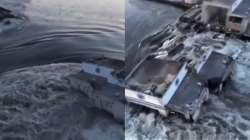VIDEO: Russia blitz on Kakhovka dam and hydroelectric power station brings massive flood: Zelenskyy
It was not immediately clear whether either side benefited from the damage to the dam since both Russian-controlled and Ukrainian-held lands are at risk.

The wall of a major dam in southern Ukraine collapsed Tuesday, triggering floods, endangering Europe’s largest nuclear power plant and threatening drinking water supplies as both sides in the war scrambled to evacuate residents and blamed each other for the destruction. Ukraine accused Russian forces of blowing up the Kakhovka dam and hydroelectric power station on the Dnieper River in an area that Moscow controls, while Russian officials blamed Ukrainian bombardment in the contested area. It was not possible to verify the claims.
The potentially far-reaching environmental and social consequences of the disaster quickly became clear as homes, streets and businesses flooded downstream and emergency crews began evacuations; officials raced to check cooling systems at the Zaporizhzhia Nuclear Power Plant; and authorities expressed concern about supplies of drinking water to the south in Crimea, which Russia illegally annexed in 2014.
Both Russian and Ukrainian authorities brought in trains and buses for residents. About 22,000 people live in areas at risk of flooding in Russian-controlled areas, while 16,000 live in the most critical zone in Ukrainian-held territory, according to official tallies. Neither side reported any deaths or injuries. The dam break added a stunning new dimension to Russia’s war in Ukraine, now in its 16th month. Ukrainian forces were widely seen to be moving forward with a long-anticipated counteroffensive in patches along more than 1,000 kilometres of the front line in the east and south.
Blame game starts
It was not immediately clear whether either side benefited from the damage to the dam since both Russian-controlled and Ukrainian-held lands are at risk. The damage could also hinder Ukraine’s counteroffensive in the south and distract its government, while Russia depends on the dam to supply water to Crimea.
Although Kyiv officials claimed Russia blew up the dam to hinder the counteroffensive, observers note that crossing the broad Dnieper would be extremely challenging for the Ukrainian military. Other sectors of the front line are more likely avenues of attack, analysts say. Experts have previously said the dam was in disrepair, which could also have led to the breach. David Helms, a retired American scientist who has monitored the reservoir since the start of the war, said in an email that it wasn’t clear if the damage was deliberate or simple neglect from Russian forces occupying the facility. But Helms also noted a Russian history of attacking dams.
Authorities, experts and residents have expressed concern for months about water flows through — and over — the Kakhovka dam. After heavy rains and snow melt last month, water levels rose beyond normal levels, flooding nearby villages. Satellite images showed water washing over damaged sluice gates.
What Zelenskyy says?
Amid official outrage, Ukrainian President Volodymyr Zelenskyy said he convened an urgent meeting of the National Security Council. He alleged Russian forces set off a blast inside the dam structure at 2:50 a.m. (2350 GMT Monday) and said about 80 settlements were in danger. Zelenskyy said in October his government had information that Russia had mined the dam and power plant.
But Kremlin spokesman Dmitry Peskov called it “a deliberate act of sabotage by the Ukrainian side … aimed at cutting water supplies to Crimea.” Both sides warned of a looming environmental disaster. Ukraine’s Presidential Office said some 150 metric tons of oil escaped from the dam machinery and that another 300 metric tons could still leak out. Andriy Yermak, the head of Ukraine’s President’s Office, posted a video showing swans swimming near an administrative building in the flooded streets of Russian-occupied Nova Kakhovka, a city in the Kherson region where some 45,000 people lived before the war. Other footage he posted showed flood waters reaching the second floor of the building.
Ukraine’s Interior Ministry urged residents of 10 villages on the Dnieper’s right bank and parts of the city of Kherson downriver to gather essential documents and pets, turn off appliances, and leave, while cautioning against possible disinformation. The Russian-installed mayor of occupied Nova Kakhovka, Vladimir Leontyev, said it was being evacuated as water poured into the city.
(With inputs from agency)
Also Read: Is Russia facing ammunition shortage? 'buying back' arms parts exported to India and Myanmar